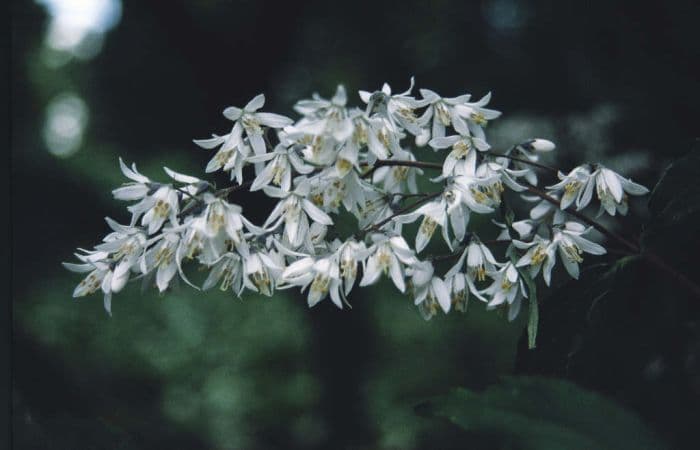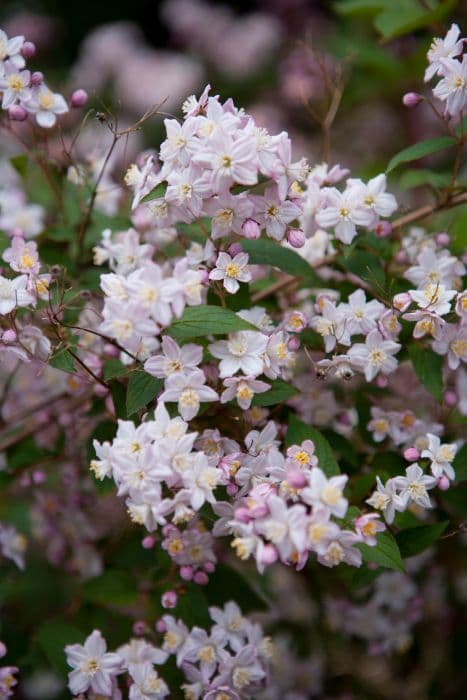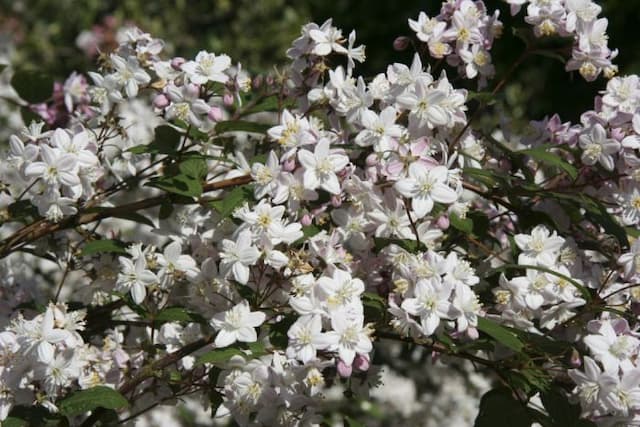Ningpo Deutzia Deutzia ningpoensis

ABOUT
Deutzia ningpoensis, commonly referred to as Ningpo deutzia, is a deciduous shrub that exhibits a bushy and spreading form. This appealing garden plant is recognized for its abundant flowering and attractive foliage. During the blooming season, Ningpo deutzia becomes a focal point, adorned with clusters of beautiful, white flowers that often have a faint pink tinge. These blossoms are small yet numerous, arranged in conical or cylindrical shapes that gracefully dangle from the stems. The leaves of Ningpo deutzia are narrow and elongated, featuring a fine, serrated edge that gives them a delicate look. They possess a deep green color that forms a lush backdrop for the profuse floral display in spring. As autumn approaches, the foliage may take on subtle shades of yellow or purple, adding another layer of visual interest to the plant. Ningpo deutzia's bark is another distinct characteristic, which peels in strips to reveal a multi-toned surface underneath. This exfoliating bark adds textural variety and year-round interest, even when the plant is not in flower. Overall, Ningpo deutzia is prized for its elegant structure, with gracefully arching branches that lend a soft, cascading effect to the landscape. Its ornamental value is elevated by the seasonal changes it undergoes, offering gardeners a plant with dynamic appeal throughout the year.
About this plant
 Names
NamesFamily
Hydrangeaceae
Synonyms
Ningpo Deutzia
Common names
Deutzia discolor, Deutzia discolor var. purpurascens.
 Toxicity
ToxicityTo humans
Deutzia ningpoensis, commonly known as Ningpo deutzia, is not known to be toxic to humans. There are no well-documented cases of toxicity or symptomatic poisoning in humans from ingesting or handling this plant. Therefore, accidental ingestion is not expected to cause harm beyond the typical risks of ingesting non-food plants (such as potential for gastrointestinal discomfort or allergic reactions).
To pets
Ningpo deutzia is not recognized as a toxic plant to pets either. It does not appear on common toxic plant lists for dogs or cats provided by organizations such as the ASPCA. Therefore, ingestion of Ningpo deutzia by pets is unlikely to result in significant poisoning or severe symptoms. However, as with any non-food plant, consumption in large quantities may cause mild gastrointestinal upset such as vomiting or diarrhea in sensitive individuals.
 Characteristics
CharacteristicsLife cycle
Perennials
Foliage type
Deciduous
Color of leaves
Green
Flower color
White
Height
6-10 feet (1.8-3 meters)
Spread
4-6 feet (1.2-1.8 meters)
Plant type
Shrub
Hardiness zones
5
Native area
China
Benefits
 General Benefits
General Benefits- Aesthetic Value: Deutzia ningpoensis, also known as Ningpo deutzia, offers ornamental appeal with its delicate white flowers and lush foliage, enhancing garden beauty.
- Habitat for Wildlife: The plant provides shelter and food for various insects and birds, supporting local biodiversity.
- Low Maintenance: Ningpo deutzia is a hardy shrub that requires minimal care once established, saving time and resources.
- Tolerance to Soil Variation: It can thrive in a range of soil types, making it adaptable to different garden conditions.
- Seasonal Interest: Ningpo deutzia exhibits seasonal changes, with flowers in spring and sometimes colorful foliage in autumn, offering year-round interest.
- Erosion Control: The shrub's root system helps stabilize soil on slopes, preventing erosion.
- Privacy Screen: When planted in groups, it can provide a dense screen for privacy and reduce noise from surroundings.
- Cultural Significance: Deutzia ningpoensis has cultural value in certain regions, potentially used in traditional gardening practices.
 Medical Properties
Medical PropertiesThis plant is not used for medical purposes.
 Air-purifying Qualities
Air-purifying QualitiesThis plant is not specifically known for air purifying qualities.
 Other Uses
Other Uses- Deutzia ningpoensis branches can be used for crafting lightweight ornaments and decorative items due to their fine-grain texture and ease of manipulation.
- The wood of Deutzia ningpoensis, being relatively hard for a small shrub, can be utilized in the creation of small woodworking projects such as jewelry boxes or picture frames.
- The flowers of Deutzia ningpoensis may be used in the art of flower pressing, where their shape and color can be preserved for scrapbooking or botanical displays.
- Fragrant compounds from the flowers of this plant can be extracted and used in the production of natural perfumes or potpourri.
- The dried and crushed leaves of Deutzia ningpoensis may serve as a natural insect repellent due to their aromatic properties.
- Its dense foliage can provide nesting opportunities for small birds, thereby enhancing local biodiversity in a garden setting.
- Due to its attractive appearance when in bloom, Deutzia ningpoensis may be planted as living fences or borders that offer privacy and aesthetic value.
- The plant can be used for educational purposes in botany courses to demonstrate the characteristics of the Hydrangeaceae family.
- Leaves of Deutzia ningpoensis can be used as a natural green dye for fabrics or paper when processed correctly.
- As a relatively hardy plant, Deutzia ningpoensis can be used in erosion control on slopes or areas prone to soil degradation.
Interesting Facts
 Feng Shui
Feng ShuiThe plant Ningpo Deutzia is not used in Feng Shui practice.
 Zodiac Sign Compitability
Zodiac Sign CompitabilityThe plant Ningpo Deutzia is not used in astrology practice.
 Plant Symbolism
Plant Symbolism- Resilience: Deutzia ningpoensis is known for its hardiness and ability to thrive in various conditions, symbolizing one's ability to persevere through challenges.
- Purity and Innocence: The delicate white flowers of the plant may represent purity and innocence, akin to the symbolism often associated with white blooms in the language of flowers.
- Temporary Beauty: As the flowering period of Deutzia ningpoensis is relatively short, it may symbolize the fleeting nature of beauty and life, reminding us to cherish the present moment.
 Water
WaterDeutzia, commonly known as Ningpo Deutzia, prefers consistent moisture but does not like to be waterlogged. Water this plant deeply once a week, providing about 1-2 gallons of water for each mature plant in the absence of rainfall. During the growing season in spring and early summer, the soil should remain moist but not soggy. Reduce watering frequency in the fall and winter when the plant is dormant, ensuring the soil doesn't dry out completely between watering sessions. Adjust watering habits depending on the weather conditions, more in extreme heat and less during rainy periods.
 Light
LightNingpo Deutzia thrives best in full sun to partial shade conditions. To ensure optimal growth and flowering, place this plant in a spot where it receives at least four to six hours of direct sunlight daily, supplemented with partial shade during the hottest part of the day. The ideal location would offer morning sun and afternoon shade, especially in regions with very intense midday sun.
 Temperature
TemperatureNingpo Deutzia does well in a wide range of temperatures, tolerating a minimum temperature around 20 degrees Fahrenheit. It prefers temperate climates with average temperatures between 50 and 75 degrees Fahrenheit. During winter, ensure that the plant is protected from extreme cold, particularly if temperatures drop below 20 degrees Fahrenheit, as this can damage the plant.
 Pruning
PruningPrune Ningpo Deutzia immediately after flowering to maintain its shape and encourage healthy growth. This is typically done in lated spring or early summer. Remove any dead or damaged branches, and thin out about one-third of the old stems to promote new growth and better air circulation. Pruning also helps to enhance flowering the following season, as Ningpo Deutzia blooms on old wood.
 Cleaning
CleaningAs needed
 Soil
SoilFor the Ningpo Deutzia, use a well-draining soil mix with a pH of 5.5 to 6.5. Incorporate organic matter like leaf mold or compost, a portion of loamy soil, and some sand or perlite for drainage to create an ideal growing medium for this plant.
 Repotting
RepottingNingpo Deutzia should be repotted every 2-3 years during its growing season. Younger plants may require more frequent repotting, while older, more established plants can be repotted less often.
 Humidity & Misting
Humidity & MistingNingpo Deutzia thrives in moderate humidity levels, typical of outdoor conditions. It does not require unusually high humidity and can tolerate the natural fluctuations of humidity found in most temperate climates.
 Suitable locations
Suitable locationsIndoor
Provide bright, indirect light and avoid dry heat sources.
Outdoor
Plant in partial sun to light shade and protect from harsh elements.
Hardiness zone
5-8 USDA
 Life cycle
Life cycleDeutzia ningpoensis, commonly known as Ningpo deutzia, starts its life cycle with germination, which occurs when environmental conditions such as temperature and moisture levels are suitable for seed growth. The seedling emerges and develops into a juvenile plant, featuring a small rosette of leaves and a slowly developing root system. As the plant matures, it enters a vegetative state characterized by rapid growth of stems and foliage. Ningpo deutzia reaches reproductive maturity within a few years, producing clusters of fragrant, white to light pink flowers in late spring to early summer. After pollination, typically by insects, it forms small capsule-like fruits that release seeds for the next generation. In the dormant stage during winter, the plant experiences a period of reduced metabolic activity before the cycle begins anew with the return of spring.
 Propogation
PropogationPropogation time
Spring to Summer
Deutzia ningpoensis, commonly known as Ningpo deutzia, is often propagated by softwood cuttings, which is the most popular method for multiplying these plants. This process typically takes place in late spring or early summer when the plant's new growth is still tender and flexible. To propagate Ningpo deutzia using this method, take a cutting approximately 4 to 6 inches (about 10 to 15 centimeters) long from a healthy, non-flowering stem. Remove the lower leaves to expose the nodes and dip the cut end into a rooting hormone to encourage root growth. Next, plant the cutting in a mixture of peat and perlite, ensuring that at least one node is buried beneath the surface. The cutting should be kept in a warm, humid environment with indirect light until roots develop, after which it can be transplanted to a more permanent location.







![Hydrangea [Early Sensation]](/_next/image?url=https%3A%2F%2Fplants-admin.emdemapps.com%2Fimages%2Fplants%2F%2Fimages%2F604b6150338db.png&w=640&q=75)

